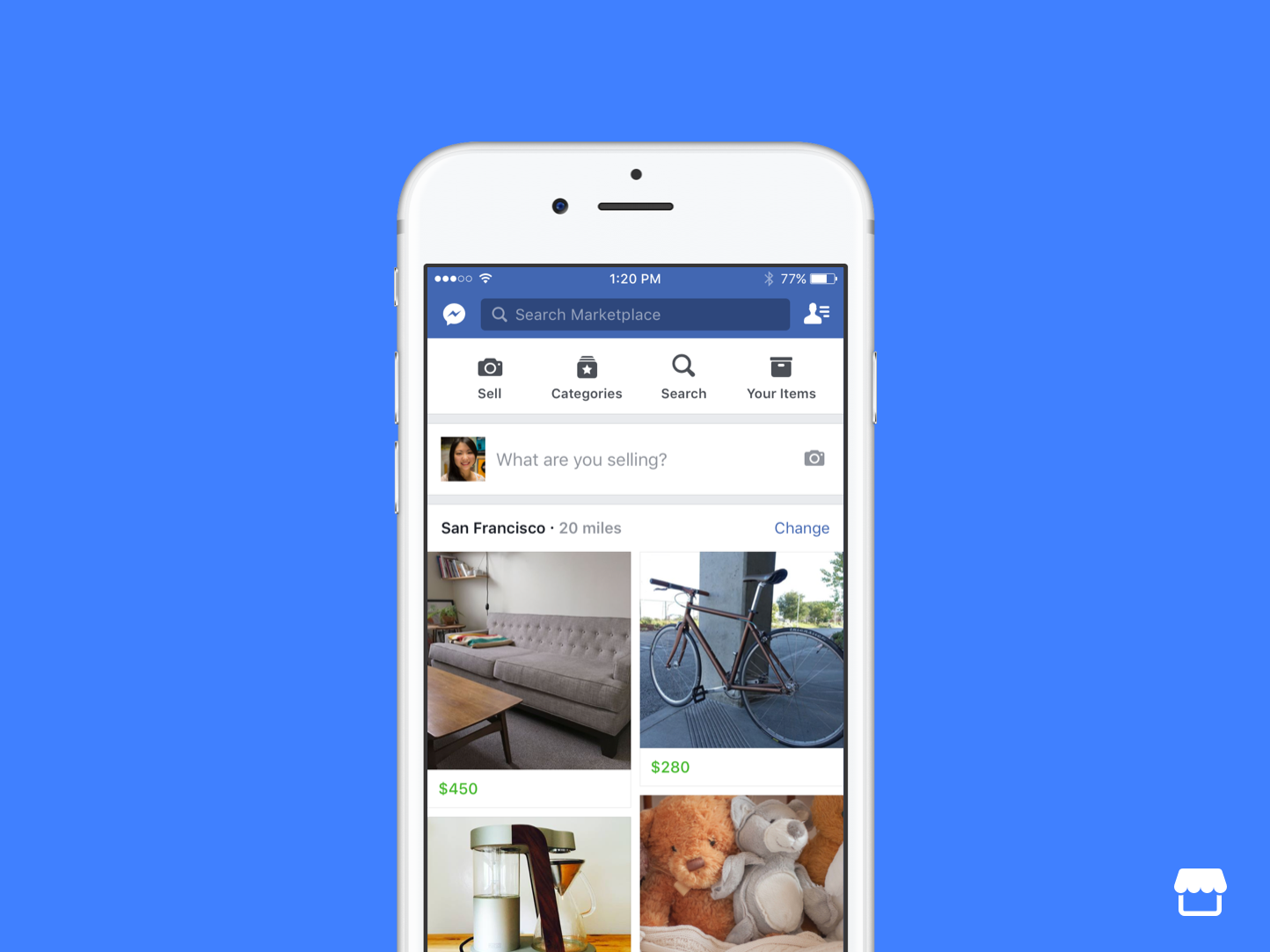Facebook Marketplace has shifted from a simple classifieds board to a data-driven commerce engine that touches nearly every stage of the local buying journey. In 2025 it processes billions of daily impressions, feeds Meta’s broader e-commerce push, and—thanks to fresh AI tooling—now feels less like a social add-on and more like a full-fledged marketplace with its own culture, rules, and revenue model.
Below you’ll find the latest landscape, practical playbooks, and the new tech shaping how people turn listings into real-world deals

Marketplace’s Share of Social Commerce
- 51 % of social shoppers’ most recent purchases now originate inside Marketplace, not Shops or Instagram Checkout.
- Furniture, consumer electronics, baby gear, and athleisure dominate volume; real-estate listings have quietly exploded as agents syndicate MLS photos to 20-plus local groups for low-cost lead gen, converting roughly one-third of posts into qualified inquiries.
Facebook Marketplace Ban? How to Get Back in the Game
Having your Facebook Marketplace seller account banned can be incredibly frustrating, especially if you believe it was done incorrectly. But don’t lose hope! Facebook provides a way to appeal the decision and potentially reinstate your account. Here’s what you need to know:
Understanding Why Bans Happen
Facebook Marketplace has community standards and commerce policies to ensure a safe and trustworthy environment for buyers and sellers. Accounts can be banned for various reasons, including:
Violating Community Standards: This includes posting prohibited items (like firearms or drugs), using hate speech, or engaging in harassment.
Breaching Commerce Policies: This covers issues like selling counterfeit goods, misrepresenting items, or having too many canceled orders.
Suspicious Activity: Facebook may flag accounts that exhibit unusual behavior, such as creating multiple accounts or receiving a high volume of negative feedback.
Steps to Appeal a Ban
If you believe your account was banned incorrectly, follow these steps to appeal:
1. Go to the Facebook Marketplace Help Center: Visit the Facebook Marketplace Help Center and look for information about banned accounts or appeals.
2. Find the Appeal Form: There should be a form or link to submit an appeal for a banned Marketplace account.
3. Provide Account Information: You’ll likely need to provide your Facebook account name, email address, and details about the ban.
4. Explain Your Situation: Clearly and concisely explain why you believe the ban was a mistake. Provide any evidence to support your claim, such as order confirmations or positive feedback from previous transactions.
5. Submit the Appeal: Review your appeal and submit it to Facebook.
Tips for a Successful Appeal
Be Polite and Professional: Maintain a respectful tone in your appeal, even if you’re frustrated.
Be Specific: Provide clear details about the ban and any relevant information to support your case.
Be Patient: It may take some time for Facebook to review your appeal. Avoid submitting multiple appeals, as this could further delay the process.
What to Do While Waiting
Review Marketplace Policies: Take the time to carefully review Facebook Marketplace’s community standards and commerce policies to understand the rules and ensure you haven’t inadvertently violated any.
Gather Evidence: If you have any evidence to support your appeal, such as positive customer reviews or order confirmations, gather it in a readily accessible format.
Preventing Future Bans
Follow the Rules: Adhere to Facebook Marketplace’s community standards and commerce policies.Provide Accurate Descriptions: Be honest and transparent in your product descriptions and photos.
Communicate Clearly: Respond promptly to buyer inquiries and messages.
Ship Items on Time: Process and ship orders promptly to avoid cancellations and negative feedback.
By following these guidelines and maintaining a positive track record on Facebook Marketplace, you can reduce the risk of future bans and enjoy a successful selling experience.
AI Everywhere: From “List” to “Match”
- Aug2Search—Meta’s new retrieval model trained on 100 M synthetic query–listing pairs—boosts search relevance by ~4 %, making long-tail items easier to surface.
- Image-recognition now guesses title, category, and price band straight from a photo; Llama-3 powered prompts auto-fill specs (“256 GB, unlocked, midnight”) before you finish typing.
- Sellers can one-tap generate a 15-second vertical video that stitches photos, price, and voice-over, then cross-post to Reels for extra reach.

The 2025 Fee Reality
- Shipping transactions: 10 % seller fee (min $0.80) plus payment processing.
- Local pick-up: still free, driving a renaissance in curb-side and coffee-shop meet-ups.
- Pro tip: work the margin by bundling small items or setting “buyer pays label” to keep more of each sale.
Scam Pressure and How to Beat It
| Scam Tactic (2025 edition) | Telltale Signs | Counter-Move |
|---|---|---|
| Zelle / Venmo “business account” switch | Buyer insists on instant transfer “to secure the item” | Stick to cash for local or Meta Pay/PayPal Goods & Services for shipped items |
| QR-code deposit scheme | Seller texts a code “to verify you” | Never scan or send outside codes; they hijack your login |
| Fake title & VIN reports | Vehicle seller demands you buy a $29.99 report from a specific link | Pull Carfax yourself or walk away |
| Inventory “overpayment” | Buyer “accidentally” sends $200 extra, asks refund | Wait for cleared funds only; never refund overages |
Local police departments now staff Safe Exchange Zones with 24/7 cameras; map one before large-ticket meet-ups.
Demographics and Demand Trends
- Gen Z & Young Millennials fuel the fastest growth: sustainability, price pressure, and the joy of “flipping” make Marketplace their first stop before Amazon.
- Engagement is highest in India, the U.S., and Brazil; U.S. peak traffic hits 7 – 9 p.m. local time, so schedule renewals accordingly.
- Macroeconomy matters: resale volumes jumped 12 % during Q1’s inflation spike, but sellers also report more tire-kickers—use auto-replies and minimum-price filters to weed them out.
New Tools for Power Sellers
- Seller Mode toggles between personal and business profiles with a tap.
- Custom “Quick Replies” handle FAQs (“Is this available?”) automatically.
- Meta Verified badges roll out for high-volume accounts, adding a blue check and expanded appeal capability.
- Bulk renew & auto-boost options let you refresh stale listings without manual reposting—critical in slower 2025 demand cycles.
Buyer & Seller Playbooks for 2025
For Buyers
- Research first: reverse-image-search suspicious photos; read seller ratings; ask for live pictures.
- Lock communication inside Messenger; push-outs to SMS or WhatsApp are red flags.
- Meet smart: well-lit public space, bring a friend, inspect on the spot (power on laptops, confirm IMEI).
- Pay protected: cash, Meta Pay, or PayPal Goods & Services; avoid gift cards and instant P2P transfers.
For Sellers
- Photos that pop: natural light, multiple angles, honest flaws; add a short Reel to appear in video search.
- Data-driven pricing: use Marketplace’s “Price Insights” plus a quick sold-items filter to set a number that moves inventory fast.
- Fast responses win: enable Quick Replies and Keep engagement inside Messenger.
- Verify funds: confirm cleared payment, count cash, or hold item until deposit shows. Never share verification codes.
- Leverage local: list high-value items as pick-up only to sidestep fees and fraud.
Staying Ahead
- Refresh listings every 7 days to reset their algorithmic “freshness.”
- Cross-post to neighborhood buy/sell groups for 30 % more impressions.
- Track fee changes—Meta experiments quarterly; be ready to adjust margins.
By mastering these shifts—fees, AI tools, safety tactics, and demand patterns—you’ll turn Facebook Marketplace from a casual flip site into a reliable profit center or a frictionless local shopping aisle.
How Does Facebook Make Money?
Facebook has grown into one of the largest tech companies in the world, yet many people don’t understand how a free platform makes money. While users don’t pay to access Facebook, the company generates billions in revenue each year. Facebook makes most of its money through advertising, specifically by showing targeted ads on its platforms including Facebook, Instagram, Messenger, and WhatsApp.
The company’s business model revolves around collecting user data and using it to help advertisers reach specific audiences. When you scroll through your feed and see sponsored posts or sidebar advertisements, that’s Facebook’s money-making machine at work. Businesses pay to place these ads in front of users who match their target demographics.
Beyond advertising, Facebook has smaller revenue streams from its Marketplace, Facebook Pay fees, and other business ventures. These additional sources help diversify its income, though they make up a much smaller portion compared to ad revenue.
Facebook, now operating under its parent company Meta Platforms (Meta), primarily makes money through advertising.
Here’s a breakdown of how it works:
- Targeted Advertising: Meta’s core business revolves around selling advertising space on its various platforms, including Facebook, Instagram, Messenger, and WhatsApp. They collect vast amounts of user data (interests, demographics, online behavior, etc.) to create detailed profiles. This allows advertisers to target very specific audiences with their ads, making them highly effective.
- Ad Auction System: Advertisers bid for ad placements through an auction system. The winning bid isn’t just about the highest monetary offer; Meta’s algorithm also considers factors like ad quality and relevance to the user, aiming to show ads that are most likely to be engaged with. This maximizes Meta’s revenue by optimizing for clicks and impressions.
- Variety of Ad Formats: Meta offers a wide range of ad formats, including News Feed ads, Stories ads, video ads, and sponsored posts, giving businesses flexibility in how they reach their audience.
- Audience Network: Beyond its own platforms, Meta’s Audience Network extends the reach of its advertising to third-party mobile apps and websites, sharing revenue with those publishers.
- Reality Labs and Other Ventures: While advertising accounts for the vast majority of Meta’s revenue (historically around 98-99%), the company is also investing in and exploring other revenue streams, primarily through its Reality Labs segment. This includes:
- Virtual Reality (VR) and Augmented Reality (AR): Sales of Oculus VR headsets and related software and experiences.
- Other Services: Smaller revenue streams might come from things like payment fees (e.g., Facebook Pay) or enterprise services.
In essence, Facebook’s business model leverages its massive user base and the data they generate to provide highly effective and targeted advertising solutions to businesses worldwide.
Key Takeaways
- Facebook generates most of its revenue through targeted advertising that uses personal data to match ads with users.
- The company offers various advertising options including self-serve ads, video ads, and sponsored content across all its platforms.
- User engagement drives Facebook’s business model, as more time spent on the platform creates more opportunities to display advertisements.
Revenue Generation Mechanisms
Facebook (now Meta) has built a robust financial engine that powers its vast social media empire. The company employs several strategic approaches to monetize its massive user base of billions across its family of apps.
Advertising Model
Facebook’s primary money-making mechanism is digital advertising, which accounts for nearly 98% of its total revenue. The platform uses sophisticated data collection to create detailed user profiles based on demographics, interests, and online behaviors. This allows advertisers to target specific audiences with remarkable precision.
Advertisers pay Facebook through two main pricing models: cost-per-click (CPC) and cost-per-thousand-impressions (CPM). The company’s advertising power comes from its massive user base – with approximately 3 billion monthly active users across its platforms including Instagram, WhatsApp, and Facebook itself.
The News Feed, Stories, and in-app placements serve as prime advertising real estate. Facebook’s algorithm ensures ads reach users most likely to engage, maximizing advertiser ROI and Meta’s revenue.
Diversification of Revenue Streams
While advertising dominates Meta’s income, the company has been expanding its revenue sources. Facebook Marketplace facilitates buying and selling between users, with Meta collecting fees from certain transactions and promoting business listings.
Virtual reality represents another growing segment through Meta’s Quest headsets and software sales in the metaverse. The company generates hardware revenue directly from device sales while building a foundation for future virtual commerce.
Business tools and services provide additional income streams. Facebook offers premium features for business pages, analytics tools, and customer service solutions that businesses pay to access.
Meta also earns through its payment infrastructure. When users make in-app purchases in games or send money through Facebook Pay, the company takes a percentage of these transactions.
Strategies for User Engagement and Growth
Facebook employs several tactics to keep users active on their platform while continuing to expand their reach. These strategies focus on enhancing user experience and strategic business moves to capture new audiences.
Innovative Features and User Experience
Facebook constantly updates its platform with new features to keep users engaged. The News Feed algorithm presents personalized content based on users’ interests and past behaviors, encouraging longer browsing sessions.
Stories, introduced after seeing success on Instagram, provide temporary content that creates FOMO (fear of missing out) and increases daily check-ins. Similarly, Facebook Watch offers video content tailored to individual preferences.
Facebook Groups help build communities around shared interests, increasing user retention and participation. These micro-communities keep users coming back to connect with like-minded people.
The platform’s “See First” feature lets users prioritize content from their favorite connections, improving their experience and satisfaction. Facebook events and birthday reminders create practical reasons for regular engagement.
Acquisitions and Partnerships
Meta (formerly Facebook) has grown significantly through strategic acquisitions. The company purchased Instagram for $1 billion in 2012, which now boasts over a billion monthly active users. WhatsApp, acquired for $19 billion in 2014, expanded Meta’s messaging capabilities.
These acquisitions help Facebook capture different demographic groups. Instagram attracts younger users who might otherwise abandon Facebook, while WhatsApp provides global reach in markets where messaging is the primary communication method.
Partnerships with content creators and businesses also drive engagement. The platform offers tools for creators to monetize their content, incentivizing quality posts that keep audiences engaged.
Business partnerships create sponsored content and integrated experiences that make Facebook a hub for commerce, entertainment, and communication rather than just a social network.
Frequently Asked Questions
Facebook’s revenue model goes beyond simply offering a free social media platform. The company has developed sophisticated strategies to monetize its massive user base and network of apps.
What are Facebook’s primary revenue sources?
Facebook generates most of its revenue through digital advertising. The platform allows businesses to create targeted ads based on user demographics, interests, and behaviors.
Advertising accounts for over 97% of Facebook’s total revenue. Companies pay Facebook to place ads in users’ feeds, stories, and across its family of apps.
Facebook doesn’t charge users directly for accessing the platform. Instead, it offers free services while generating income from advertisers seeking to reach its billions of users.
In what ways does Facebook monetize user data?
Facebook collects extensive data about users’ activities, preferences, and behaviors. This information helps create detailed profiles that advertisers use to target specific audiences.
The company doesn’t directly sell user data to third parties. Instead, it uses this information to create sophisticated ad targeting options that advertisers pay to access.
When users interact with content, Facebook analyzes these patterns to improve ad relevance. More relevant ads typically lead to higher click-through rates and more revenue.
How does Instagram contribute to Facebook’s revenue?
Instagram has become a major revenue driver since Facebook acquired it in 2012. The platform offers various ad formats including feed ads, story ads, and shopping features.
Instagram’s visual nature makes it particularly attractive to brands in fashion, beauty, and lifestyle sectors. These businesses pay premium rates to reach Instagram’s engaged audience.
The introduction of Instagram Shopping has created additional revenue streams by facilitating direct e-commerce transactions within the app.
What strategies does Facebook employ to monetize WhatsApp?
WhatsApp monetization has been more challenging for Facebook. The company initially promised not to introduce ads after acquiring WhatsApp.
Facebook now offers the WhatsApp Business API, which allows companies to communicate with customers. Businesses pay for messages sent after the first 24 hours of conversation.
WhatsApp Pay enables payment transfers between users in certain countries. Facebook earns transaction fees from these payments, creating another revenue source.
How does Facebook’s ad revenue model work?
Facebook uses an auction system for ad placement. Advertisers bid on ad spaces, and the highest bidders get their ads shown to relevant audiences.
The cost of Facebook ads depends on factors like target audience, ad quality, and competition. Some competitive industries pay significantly higher rates for the same ad placement.
Advertisers can choose between different billing models, including cost-per-click (CPC) or cost-per-thousand-impressions (CPM), depending on their campaign goals.
What is the potential revenue per user on Facebook?
Facebook’s average revenue per user (ARPU) varies significantly by region. North American users generate the highest revenue at approximately $32 per user annually.
European users typically generate about $10-15 per user annually. This amount is lower in developing regions where advertising markets are less mature.
The company constantly works to increase ARPU by introducing new ad formats, improving targeting capabilities, and expanding e-commerce features across its platforms.







